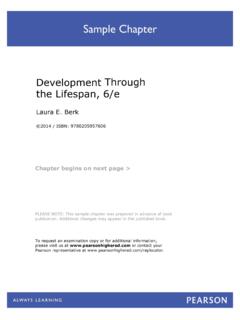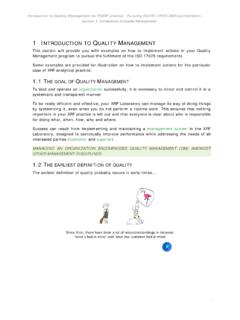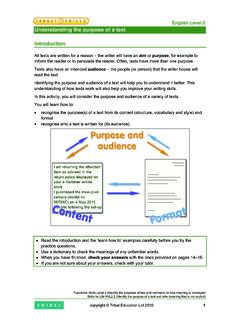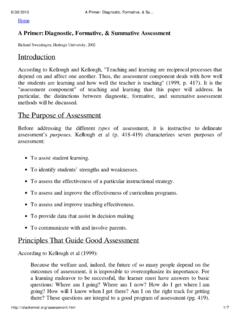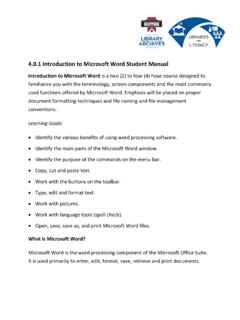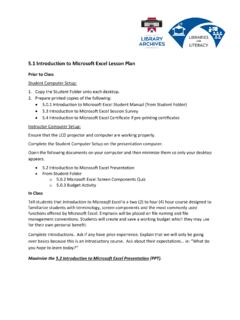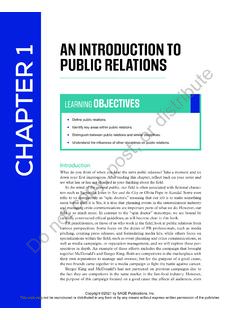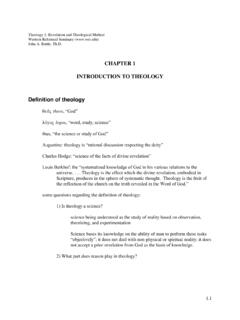Transcription of Introduction to Psychology 1 C - Pearson
1 An Introduction to Mastering the World of Psychology (pp. 2 6 ) How will the SQ3R method help you master Psychology ? Why do psychologists use the scientific method? What are the goals of Psychology ? Psychology Then and Now (pp. 7 16 ) What did the early psychologists contribute to the field? What are the major schools of thought in Psychology ? What are the seven contemporary psychological perspectives? What specialty areas exist in Psychology ? Thinking about Theories and Research (pp. 16 18 ) How do psychologists evaluate theories? How will critical thinking help you evaluate research? Descriptive Research Methods (pp. 18 23 ) What are the pros and cons of observational and case studies? How do researchers design useful surveys? What are the strengths and weaknesses of the correlational method? The Experimental Method (pp.)
2 23 28 ) How do researchers use experiments to test causal hypotheses? What are the limitations of the experimental method? Research Participants (pp. 28 30 ) How can participants characteristics influence a study s usefulness? How do researchers protect human participants and animals rights? 1 Introduction to Psychology CHAPTER The SQ3R method will help you maximize your learning in five steps: Survey Question Read Recite Review The sticky notes in Chapter 1 will help you master this learning system so that you can use it on your own in the remaining chapters. 11/31/13 1:14 PM An Introduction to Mastering the World of Psychology A Ugandan expression says, The hunter in pursuit of an elephant does not stop to throw stones at birds. In other words, to achieve any goal, including succeeding in a Psychology course, one must remain focused on it.
3 The study strategies we have incor-porated into Mastering the World of Psychology can help you stay focused on your goal of successfully completing your course in introductory Psychology . Here is how the features of the text can help you. Study and Review on MyPsychLabRead on MyPsychLabSimulate on MyPsychLabListen on on MyPsychLabView on MyPsychLabMap on MyPsychLabExplore on MyPsychLabIN MARGININ LINE ICONS Studying Psychology : Some Tricks of the Trade To help you maximize your learning, Mastering the World of Psychology includes a set of tried and true study strategies Survey, Question, Read, Recite, and Review that are collectively known as the SQ3R method ( Robinson, 1970 ). Here s how to make the most of the SQ3R features that we have included in Mastering the World of Psychology : step 1: Survey. The goal of the survey step is to get the chapter s big picture, a men-tal map of what it s all about.
4 That s the purpose of the list of learning questions at the beginning of each chapter. The questions give you a blueprint to use as you navigate through the chapter and tell you what you will learn in each section. Use the learning questions to create a note-taking outline that you will fill in as you read the chapter. Next, look over the major elements of the chapter. These elements include the chapter-opening activity called Think About It, the section headings, Summarize It tables, Try It activities, Explain It boxes, and Apply It boxes. You should also survey the learning questions in the margins by each subheading (the same questions that are listed at the beginning of the chapter) and the boldfaced terms that are also in the margins. Next, skim over the Chapter Summary. It includes answers for all the learning questions. Next, do the Think About It activity at the beginning of the chapter, keeping in mind the mental overview of the chapter that you constructed with the help of the learning questions.
5 Now you re ready to start working your way through the chapter. How will the SQ3R method help you master Psychology ? SQ3R method A study method involving the following five steps: (1) survey, (2) question, (3) read, (4) recite, and (5) review. 2 Chapter 1 Introduction to Psychology Here you are taking your first Psychology course and wondering what it s all about. When you focus on the word Psychology , what ideas spring to mind as you concentrate? Do terms such as therapy, brain, psychological disorder, emotion, and hypnosis come to mind? Your introductory Psychology course will touch on all of these concepts, but it will also help you learn how to deal with pressing practical issues in your everyday life. How can you study more effectively? (You can start answering this one by reading the Apply it section on page 4 .) How can you know which career is right for you? How can you solve conflicts and maintain satisfying relationships with others?
6 These are the kinds of practical questions that a good understanding of Psychology can help you answer? Let s begin your exploration of Psychology with an assessment of how much you already know, or think you know, about the topic: Indicate whether each statement is true (T) or false (F). 1. Once damaged, brain cells never work again. 2. All people dream during a night of normal sleep. 3. As the number of bystanders at an emergency increases, the time it takes for the victim to get help decreases. 4. Humans do not have a maternal instinct. 5. It s impossible for human beings to hear a watch ticking 20 feet away. 6. Eyewitness testimony is often unreliable. 7. Chimpanzees have been taught to speak. 8. Creativity and high intelligence do not necessarily go together. 9. When it comes to close personal relationships, opposites attract. 10. The majority of teenagers have good relationships with their parents.
7 You may be surprised to learn that all the odd-numbered items are false, and all the even-numbered items are true. Learning all you can from this text is a good first step toward a better understanding of behavior and mental processes. The text s features will help you learn because they are part of a systematic that is, a goal-oriented, planned, and effortful way of studying. Similarly, the procedures that scientists use yield reliable answers to questions about behavior and mental processes because they are part of a systematic approach to what some philosophers deem to be the primary goal of science: to search for truth ( Popper, 1972 ). THINK ABOUT IT Step 1: Survey Read over the learning objectives in the outline at the beginning of the chapter. Look over the other major elements of the chapter. They include the following: Think About It chapter opener Key terms Summarize It tables Try It activities Explain It boxes Apply It boxes Skim the Chapter Summary.
8 Create note-taking outline you ll use as you read the chapter. Your outline will include these elements: The titles and main ideas of the chapter s sections The learning questions each section answers Do the Think About It activity at the beginning of the chapter. Study and Review on MyPsychLabRead on MyPsychLabSimulate on MyPsychLabListen on on MyPsychLabView on MyPsychLabMap on MyPsychLabExplore on MyPsychLabIN MARGININ LINE ICONS the Video Episode 1: Thinking Like a Psychologists Debunking Myths in Study and Review on MyPsychLabRead on MyPsychLabSimulate on MyPsychLabListen on on MyPsychLabView on MyPsychLabMap on MyPsychLabExplore on MyPsychLabIN MARGININ LINE ICONS 21/31/13 1:14 PMAn Introduction to Mastering the World of Psychology 3step 2: Question. Do the Question step as you come to each subheading in the chapter. This step has two parts: First, read the learning question in the margin.
9 For instance, the learning question for this subsection is How will the SQ3R method help you master Psychology ? Next, think of additional questions you have about the topic and add them to the note-taking outline you created notes in the Survey 3: Read. Read the text under each subheading, keeping in mind the learning question and your own questions. Use the Apply It boxes, Try It activities, Explain It boxes, and Summarize It tables, if any are present, to help you understand the 4: Recite. When you finish reading each subsection, answer its learning question and your own questions aloud in your own words. Jot your answers, along with brief definitions for the section s key terms, in your outline. When you re finished, look back at the section to see if you ve missed anything and modify your notes if neces-sary. Repeat this process for each subsection and you ll end up with a well-organized set of notes on the entire 5a: Review I. To be sure you ve understood each major section before you move on to the next one, answer the Remember It questions.
10 You should find many of the answers in your notes. If you don t, you should probably go back and revise them. Next, log on to MyPsychLab and take the section s Quick Review quiz. Research shows that repeated testing is one of the most effective study strategies you can use (Karpicke, Butler, & Roediger, 2009).step 5b: Review II. After you have worked your way through the all the major sec-tions, you need to review the entire chapter to be sure that you re ready to be tested on it. Begin by reading the Chapter Summary and comparing it to your notes. Revise your notes if necessary. Next, complete the Study Guide and check your answers against the key in the back of the book. Revisit your notes and restudy the parts of the chapter you scored the lowest on in the Study Guide. Finally, take the chapter Practice Test in the back of the book or log on to MyPsychLab to take the online Chapter Exam. Reread the parts of the chapter that relate to any questions that you miss, and be sure that you understand where you went wrong.








